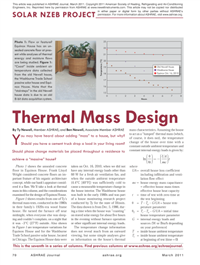Designing for ZERO Newsletter Series: ASHRAE Journal Solar NZEB Project: Designing a Thermally Massive Home

Another surprising feature of Equinox House is its very high “thermal mass”. It is especially surprising because no extra mass (concrete, masonry, phase change materials) was added to Equinox House. By comparison, the Washburne House, a 1980’s era “passive solar” house was very massive with concrete floors, 2 story stone chimney, water storage tanks, and room filled with a special phase change material, but not “thermally massive”. Thermal mass, characterized by the time required for a house to coast toward thermal equilibrium with its surroundings, is 110hours for Equinox House versus 22 hours for the Washburne House. Other factors, such as insulation, sealing, and window area are very important, too. Why is thermal mass important? Occupant comfort and energy cost are both impacted by thermal mass. Window area reduces thermal mass, making a home’s comfort difficult to control and with today’s “time-of-day” electric rates, can cause high energy usage during peak energy rate time periods.
We hope our article provides some guidance on thermal mass for your next project!
























